Related Research Articles

The Swiss Federal Institute of Technology in Lausanne (EPFL) is a public research university in Lausanne, Switzerland. Established in 1969, it has placed itself as a public research university specializing in engineering and natural sciences.

Computational physics is the study and implementation of numerical analysis to solve problems in physics. Historically, computational physics was the first application of modern computers in science, and is now a subset of computational science. It is sometimes regarded as a subdiscipline of theoretical physics, but others consider it an intermediate branch between theoretical and experimental physics — an area of study which supplements both theory and experiment.
GROningen MOlecular Simulation (GROMOS) is the name of a force field for molecular dynamics simulation, and a related computer software package. Both are developed at the University of Groningen, and at the Computer-Aided Chemistry Group at the Laboratory for Physical Chemistry at the Swiss Federal Institute of Technology (ETH Zurich). At Groningen, Herman Berendsen was involved in its development.
Giovanni Ciccotti is an Italian physicist.
Loup Verlet was a French physicist who pioneered the computer simulation of molecular dynamics models. In a famous 1967 paper he used what is now known as Verlet integration and the Verlet list. He received his PhD in 1957; his PhD work was initially conducted in the group of Victor Weisskopf at the Massachusetts Institute of Technology and concluded under the guidance of Maurice Lévy at the École normale supérieure in Paris. From 1957 to 1993 he worked mostly on the physics of the liquid state.
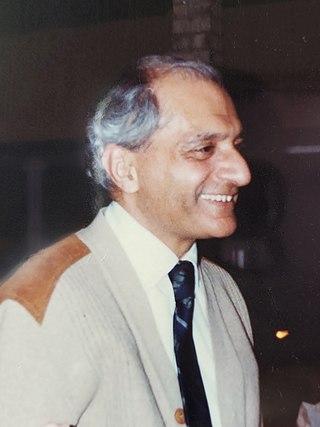
Aneesur Rahman was an Indian-born American physicist who pioneered the application of computational methods to physical systems. His 1964 paper on liquid argon studied a system of 864 argon atoms on a CDC 3600 computer, using a Lennard-Jones potential. His algorithms still form the basis for many codes written today. Moreover, he worked on a wide variety of problems, such as the microcanonical ensemble approach to lattice gauge theory, which he invented with David J E Callaway.
In computer software, Orac is a classical molecular dynamics program, to simulate complex molecular systems at the atomistic level. In 1989-1990, the code was written originally by Massimo Marchi during his stay at International Business Machines (IBM), Kingston (USA). In 1995, the code was developed further at the Centre européen de calcul atomique et moléculaire (CECAM). It is written in the programming language Fortran. In 1997, it was released under a GNU General Public License (GPL). The latest release of Orac may be run in parallel using the standard Message Passing Interface (MPI) libraries, allowing replica exchange simulations, multiple walkers metadynamics simulations and multiple steered molecular dynamics nonequilibrium trajectories.
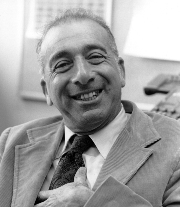
Berni Julian Alder was a German-born American physicist specialized in statistical mechanics, and a pioneer of computational modelling of matter.
Roberto Car is an Italian physicist and the Ralph W. Dornte *31 Professor in Chemistry at Princeton University, where he is also a faculty member in the Princeton Institute for the Science and Technology of Materials. He conducts research on the simulation of molecular dynamics phenomena.
Sauro Succi is an Italian scientist, internationally credited for being one of the founders of the successful Lattice Boltzmann method for fluid dynamics and soft matter.
The following timeline starts with the invention of the modern computer in the late interwar period.
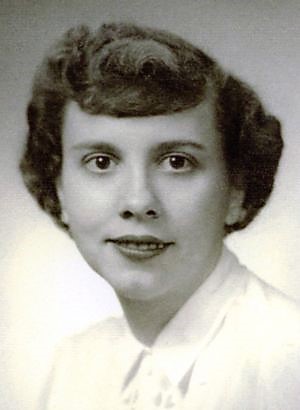
Mary Tsingou is an American physicist and mathematician of Greek-Bulgarian descent. She was one of the first programmers on the MANIAC computer at Los Alamos National Laboratory and is best known for having coded the celebrated computer experiment with Enrico Fermi, John Pasta, and Stanislaw Ulam. This experiment became an inspiration for the fields of chaos theory and scientific computing, and was a turning point in soliton theory.
Melody A. Swartz is a professor and vice dean for faculty affairs at the University of Chicago who pioneered research in engineering complex tissues. Her most cited work "Capturing complex 3D tissue physiology in vitro" has been cited over 1784 times. Her research is focused on understanding the role of the lymphatic system regulating immunity in homeostasis and diseases, particularly cancer. She was previously director of the Institute of Bioengineering at the École Polytechnique Fédérale de Lausanne. She was elected to the National Academy of Engineering in 2023, the Royal Academy of Medicine of Belgium in 2023, and the National Academy of Medicine in 2020.
This is a timeline of key developments in computational mathematics.

Ursula Röthlisberger is a professor of computational chemistry at École Polytechnique Fédérale de Lausanne. She works on density functional theory using mixed quantum mechanical/molecular mechanical methods. She is an associate editor of the American Chemical Society Journal of Chemical Theory and Computation and a fellow of the American Association for the Advancement of Science.

Erna Hamburger was a Swiss engineer and professor. In 1957, she became professor of electrometry at the University of Lausanne. She was the first woman in the history of Switzerland to be named a professor at a STEM university.
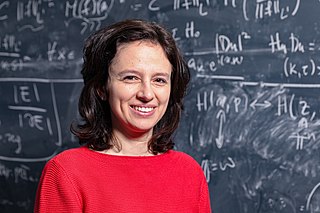
Maria Colombo is an Italian mathematician specializing in mathematical analysis. She is a professor at the EPFL in Switzerland, where she holds the chair for mathematical analysis, calculus of variations and partial differential equations.
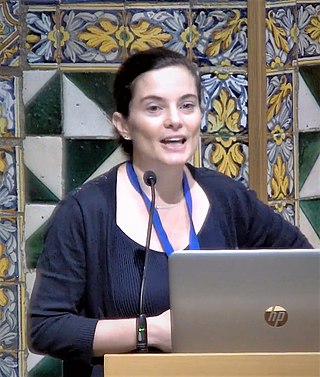
Clémence Corminboeuf is a Swiss chemist who is Professor of Computational chemistry at the École Polytechnique Fédérale de Lausanne. She was awarded the Swiss Chemical Society 2021 Heilbronner-Hückel Award.

Lucia Reining is a German theoretical spectroscopist who works in France as a director of research with the French National Centre for Scientific Research (CNRS), in the Laboratoire des Solides Irradiés at the École Polytechnique.
References
- 1 2 3 4 Jollien, Nathalie (4 November 2018). "Interview: Mary Ann Mansigh Karlsen, codeuse de la première heure" (in French). École Polytechnique Fédérale de Lausanne . Retrieved 13 February 2021.
- ↑ "PRL Top Ten: #3". American Physical Society.
- 1 2 Battimelli, Giovanni; Ciccotti, Giovanni; Greco, Pietro (2020). Computer Meets Theoretical Physics The New Frontier of Molecular Simulation. Springer International Publishing. pp. 45–46. ISBN 9783030393991 . Retrieved 12 February 2021.
- ↑ Mansigh Karlsen, Mary Ann (April 2017). "The Early Years of Molecular Dynamics and Computers at UCRL, LRL, LLL, and LLNL". In Schwegler, Eric; Rubenstein, Brenda M.; Libby Stephen B. (eds.). Advances in the Computational Sciences: Symposium in Honor of Dr Berni Alder's 90th Birthday. World Scientific Publishing. pp. 176–183. Bibcode:2017acs..conf..176M. doi:10.1142/9789813209428_0012. ISBN 9789813209428.
{{cite book}}:|journal=ignored (help) - ↑ "Almost famous, a woman behind the codes: Mary Ann Mansigh Karlsen". Swiss National Science Foundation (NCCR-Marvel). 15 November 2017. Retrieved 13 February 2021.
CECAM and NCCR MARVEL have the pleasure to invite you on Wednesday November 15 at 17:30 to meet a truly outstanding representative of the first generation of coders: Mary Ann Mansigh Karlsen
- ↑ "Materials Cloud". www.materialscloud.org.
- 1 2 "Exclusively female lunch: Tales of a Computer Pioneer with Mary Ann Mansigh Karlsen". École Polytechnique Fédérale de Lausanne. 14 November 2017. Retrieved 13 February 2021.
- ↑ "Media Coverage: Role of women in the early history of computer simulation, CECAM, Lausanne". Nanotrans. 11 May 2017. Retrieved 13 February 2021.
Daan Frenkel participated in the conversatory "Role of women in the early history of computer simulation" (Dissemination about computer simulation in general): Symposium at CECAM, Lausanne, honouring Mary Ann Mansigh, pioneer of Molecular Dynamics Simulations
- ↑ Frankel, Daan (2013). "Simulations: The dark side" (PDF). European Physical Journal Plus . 128 (10): 4. arXiv: 1211.4440 . Bibcode:2013EPJP..128...10F. doi:10.1140/epjp/i2013-13010-8. S2CID 119218193.
However, he/she (more "he" than "she" in the 50's and 60's — Arianna Rosenbluth and Mary-Ann Mansigh are notable exceptions) would not have been able to predict the tools that we now use to study rare events, quantum systems or free-energy landscapes.
- ↑ "CECAM/MARVEL Mary Ann Mansigh Conversation Series – Computer modelling for industrial applications". École Polytechnique Fédérale de Lausanne. 5 August 2019. Retrieved 13 February 2021.
- ↑ Mendonça, Ana Catarina (December 2019). "CECAM (also) celebrates its 50th birthday in 2019". École Polytechnique Fédérale de Lausanne . Retrieved 13 February 2021.
- ↑ Ervik, Åsmund (March 2016). "3". Multiscale modelling using molecular dynamics and interfacecapturing methods (PDF). Norwegian University of Science and Technology. p. 53. ISBN 978-82-326-1687-9 . Retrieved 13 February 2021.
It is noteworthy (and sad) that the early female programmers, like Mary Ann Mansigh who wrote the first molecular dynamics code, or Mary Tsingou who wrote the code for the Fermi-Pasta-Ulam model in 1954, were not included as authors on the papers describing the results